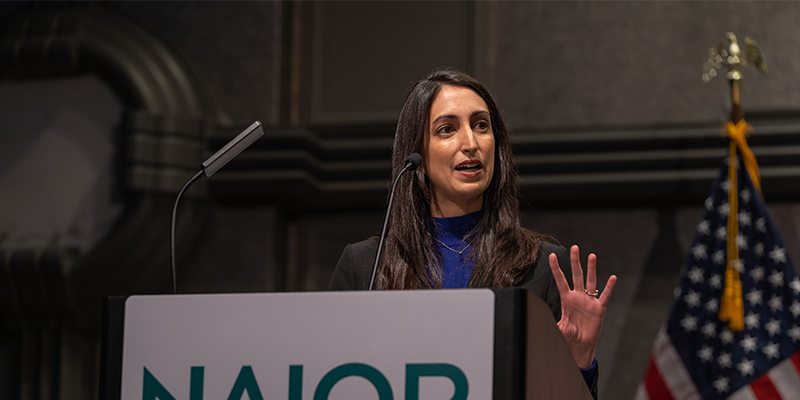Painting a picture of the current global economic climate is a complex venture, but Reva Goujon, director at Rhodium Group, leveraged her vast geopolitical expertise to do so at NAIOP’s Chapter Leadership and Legislative Retreat this week in Washington, D.C.
“First – catch your breath!” Goujon said at the start of her remarks, pointing out that 2022 created a cocktail of inflationary drivers, including:
- The land war in Europe, which caused a surge in food and energy prices.
- Tightening monetary policy (“How is the Fed going to land this plane?” she asked).
- A still-tight labor market (“There are nearly twice as many job openings as eligible workers,” Goujon noted).
- The U.S.’s “next-level” financial sanctions against Russia and tech controls against China.
- China ending its “zero-COVID” policy with a bang, among other factors.
Competing inflationary and deflationary forces are also confounding the major central banks, said Goujon. On the inflationary side, they’re seeing aging demographics, the energy transition, reorganization of global trade, and competition for power. On the deflationary side are China’s structural slowdown and disruptions in tech innovation.
Unfortunately, there seems to be no quick fix to the labor shortfalls, though labor shortages and upward pressure on wages have intensified industry calls for pragmatic immigration reform, Goujon said. She added that while inbound flows of foreign workers declined significantly between 2016 and 2020 due to immigration and travel restrictions, levels are starting to recover to pre-pandemic levels.
In China, the aging population is now a major drag on the country’s growth, with implications for the global economy. “However, markets are still expecting heroic growth from China,” said Goujon. The International Monetary Fund (IMF) assumption of 5.2% growth in China (compared to China’s own 5.5% estimate) implies China will be responsible for about 30% of global growth in 2023. However, there are major headwinds to labor, capital and productivity that cannot be easily reversed.
“The property sector specifically will be even weaker in 2023,” said Goujon. “New starts are already 46% down year-on-year. Land sales are down 57%.” The property sector alone in China can account for around 25% of GDP, “and it’s falling off a cliff right now.”
The economic models already built at major institutions like the IMF, Goujon said, haven’t caught up to this reality yet.
“We’re in kind of a scary period where a lot of companies will base their own projections off of these institutional projections, but they’re not fully taking into account what is happening in China, and as a huge force between 30-40% of growth in the world, that’s going to matter.”
For now, the U.S. sees China’s weakness as an opportunity, Goujon said, and China remains highly vulnerable to U.S.-led tech and financial restrictions. But a battle over economic sovereignty is building, testing Beijing’s restraint.
A bright spot among the gloom: tech innovation can have an explosive impact on productivity and in bringing down costs, though it takes time to see those big spurts of innovation bleed through industry, said Goujon.
“The future of biomanufacturing in particular I think is really exciting,” she said. Breweries, for example, might be adapted to expand biomanufacturing capacity. “We’re getting creative here,” Goujon said. Creativity might be just what we need to prepare for what’s ahead in 2023.








